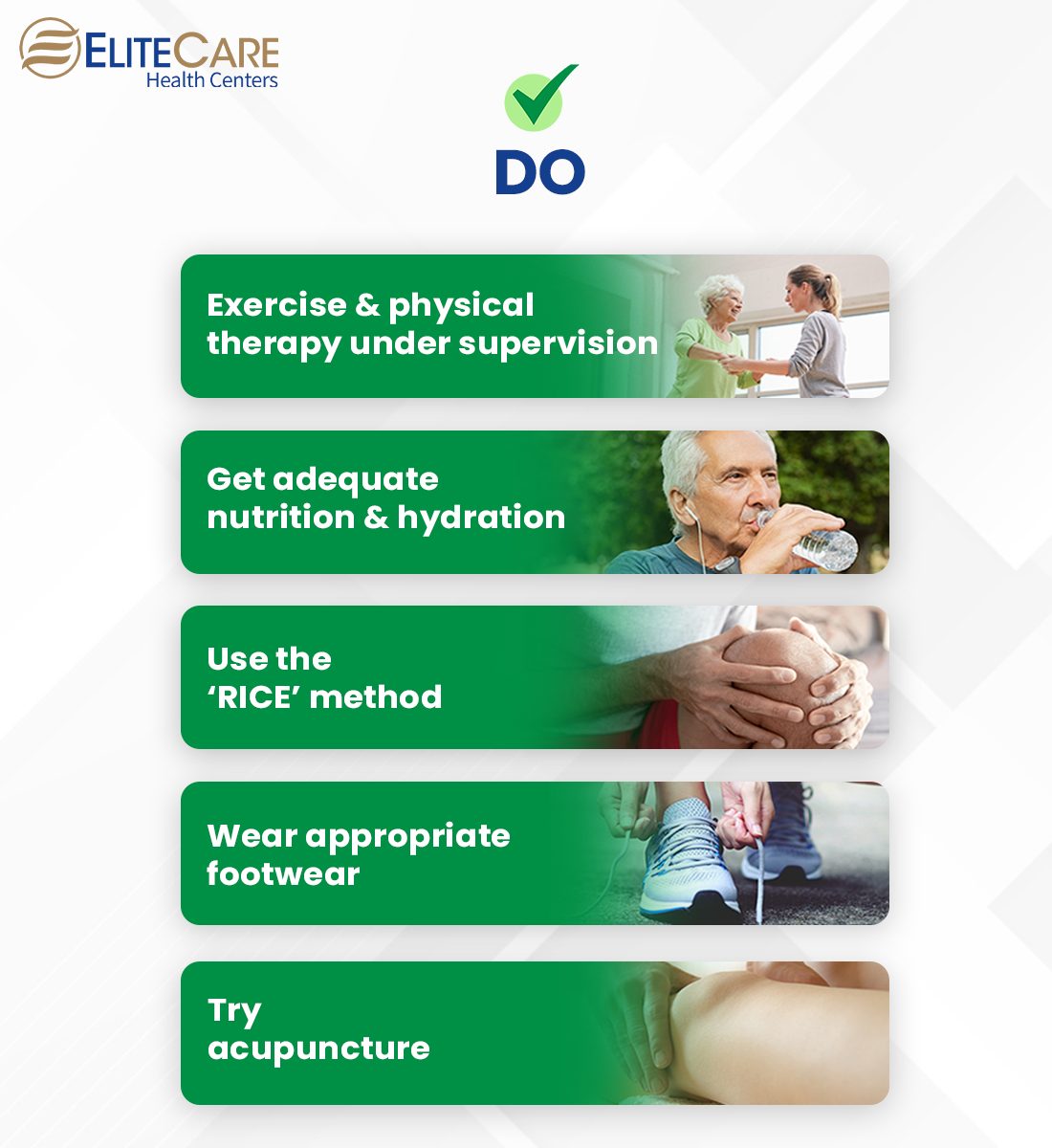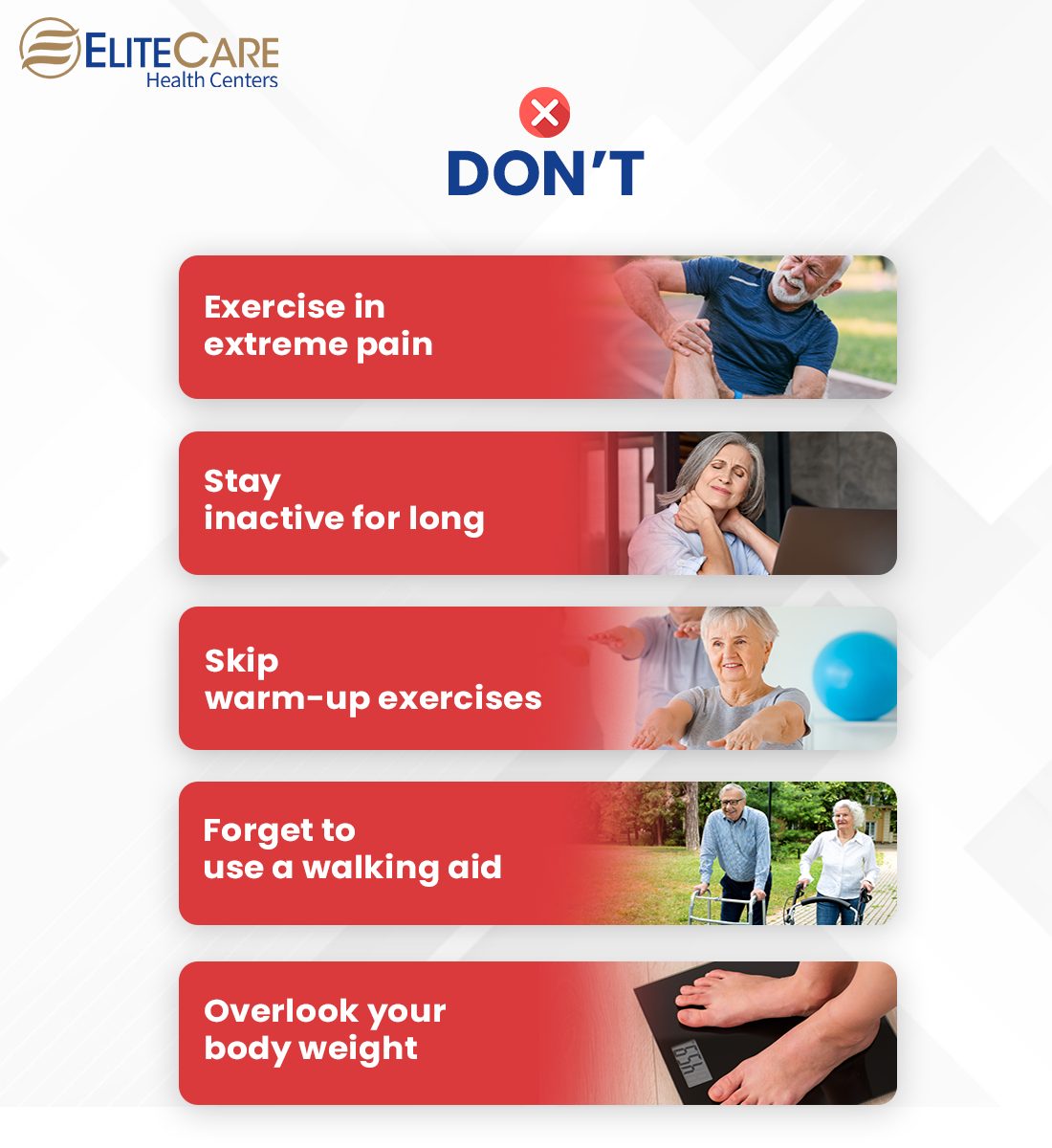
The definition of chronic knee pain is when persistent pain, swelling, or sensitivity in one or both knees occur– and lasts for approximately three months or more with no significant relief in symptoms. The prevalence of knee pain increases with age and affects the quality of life for seniors. According to a study published in the Journal of Bone and Joint Surgery*, over 50% of adults over 65 have reported knee pain in the past year. Knee sprain symptoms can vary for individuals depending on the severity of their condition.
Causes of Chronic Knee Pain in Seniors
Bone degeneration
These include cartilage loss or bone spurs. Cartilage loss refers to the wearing away of the protective layer of cartilage in the joints, causing friction and reducing joint mobility. On the other hand, a bone spur, also known as an osteophyte, is a small bony growth that forms on the surface of a bone. It develops along the edges of the joint and causes pain by impinging on surrounding soft tissue such as ligaments, tendons, or cartilage.
Previous injuries
If left untreated, a sprained knee or any other kind of knee injury can also lead to chronic pain in seniors.
Obesity
Excessive weight puts additional stress on the joints, particularly the knees, leading to chronic knee pain.
Lupus
This chronic autoimmune disease can cause inflammation in the joints, leading to joint pain, swelling, and stiffness. In addition, it can also cause knee pain by affecting the soft tissue around the knee, including the tendons and ligaments.
Hormonal Changes
Low estrogen levels in women during menopause can lead to decreased bone density and increase the risk of osteoarthritis, which can cause knee pain. In addition, hormonal fluctuations can also cause knee pain due to increased fluid retention and inflammation in the knee joint.
Genetics
Some people may have a genetic predisposition to joint problems that can lead to chronic pain.
DOs for Managing Chronic Knee Pain

1. Exercise and physical therapy under expert supervision
Studies have shown that exercise and physical therapy can strengthen joints and enhance joint flexibility, especially in individuals suffering from knee osteoarthritis. To develop a safe and effective exercise plan, seniors should consult a physician and a professional physical therapist or trainer and get detailed guidance.
Some of the most beneficial exercises for knee pain are as follows:
- Strengthening exercises like chair squats, leg presses, or resistance band exercises.
- Range-of-motion workouts like knee bend, straight leg raises, and circular knee movements.
- Low-impact aerobics activities include walking, cycling, or swimming.
2. Get adequate nutrition and hydration
Eating a well-balanced diet rich in vitamins and minerals, such as vitamin D, calcium, and magnesium, can promote bones and joints health, and provide relief from knee pain. Researchers have also found that consuming anti-inflammatory foods, such as fish, nuts, fruits, and vegetables, may also significantly improve joint function.
In addition, getting adequate hydration can play a crucial role to reduce the risk of knee injuries. Drink plenty of water to improve joint lubrication and reduce friction in the knee joint.
Consult with a provider or a registered dietitian to determine the specific nutritional needs of seniors.
3. Use the ‘RICE’ method
The RICE method is considered an effective first-aid knee sprain treatment. Doctors often recommend it alongside other treatments, such as medications, exercise, and physical therapy. Here’s how to use the RICE method for knee pain:
- Rest: Take a break from activities that are causing pain or worsening the pain. If possible, avoid putting any weight on the knee while recovering from the pain.
- Ice: Apply a cold pack or some ice wrapped in a towel to the knee for 15-20 minutes at a time. Repeat this several times a day to reduce pain, swelling, and inflammation.
- Compression: Wrap the knee with a compression bandage or knee support to aid the joint and reduce swelling.
- Elevation: Elevate the knee and keep it above the heart level as much as possible.
4. Wear appropriate footwear
Choose shoes with good arch support and cushioning to help absorb shock and reduce the impact on the hurting knees. Check for a stable base, low heel, and well-fitted shoe to prevent fall-related injuries and any additional strain on the joint.
Besides, seniors should also consider different shoes depending on the type of activity they will be doing. For instance, shoes with good grip and stability are suitable for outdoor activities, while shoes with good shock absorption are fit for running or high-impact exercises.
5. Try alternative therapy
Acupuncture is an effective form of alternative therapy to relieve knee pain in seniors. This process involves the insertion of thin, sterile needles into specific points in the body. It stimulates the areas where needles are inserted, increases blood flow and therefore helps reduce the pain.
It is always best to consult a primary care physician or a licensed therapist before undergoing any alternative remedies for knee pain.
DON’Ts for Managing Chronic Knee pain

1. Exercise in extreme pain
When seniors are experiencing severe pain, it is a sign that the joint is under too much stress and needs time to rest and heal. Exercising in extreme pain can cause further damage to the knee joint and worsen the pain, resulting in a longer recovery time.
2. Stay inactive for long
While rest is required in the short term to allow the knee to heal, too much rest can be harmful. Research has revealed that seniors who remain inactive for prolonged periods of time have a higher risk of developing knee osteoarthritis and other knee conditions causing severe knee pain. In addition, lack of movement can also lead to muscle weakness which can further put more stress on the knee joint.
Therefore, seniors need to balance rest with exercise and physical activity. Start with gentle, low-impact exercises and gradually increase the intensity when the pain is less.
3. Skip warm-up exercises
Warm-up exercises are crucial to prepare the body for physical activity by increasing blood flow to the joints.
When the body is not properly warmed up, the knee joint is less flexible, making it more vulnerable to injury and knee pain. Skipping warm-up exercises can also tighten the muscles, which can place additional stress on the knee joint.
Start each physical activity session with a 5–10-minute warm-up routine that can include gentle activities such as walking, light stretching, or low-impact aerobics.
4. Forget to use a walking aid
In some cases, using a walking aid, such as a cane or knee brace can reduce stress on the knee joint and provide support and stability. Use a walking aid as recommended by a healthcare provider to prevent the risk of falls, which can otherwise cause additional knee damage and make the pain worse.
5. Overlook your body weight
Excess body weight places additional stress on the knee joint, therefore, contributing to increased pain and inflammation. It also increases the risk of further knee injuries and damage and makes it more difficult to manage knee pain. The Arthritis Foundation estimates that an additional 10 pounds of weight can add between 15 and 50 additional pounds of pressure to a joint.
If seniors suffering from knee pain have a high BMI, consult a physician, set a target weight, and plan to reach that goal.
When to See a Doctor
Healthcare providers often recommend taking care of chronic knee pain at home following prescribed medications and additional advice. Nevertheless, seniors need to seek medical attention in case of severe pain that doesn’t go away.
Contact a provider if they experience any of the following symptoms:
- Severe pain and swelling
- Deformity or severe redness or bruising
- Persisting or worsening knee pain that stays for more than a few days
- Signs of infection, such as a fever
For any queries or concerns related to knee pain, contact EliteCare Health Centers, one of the best Florida medical clinics. Visit your nearest center or call us at 1-888-596-2090 to schedule an appointment with our board-certified physicians.






